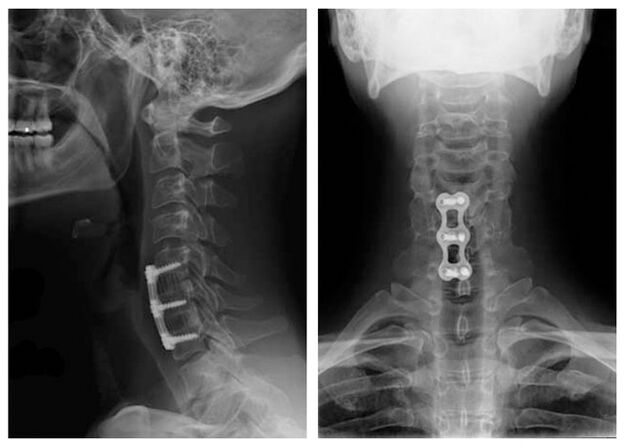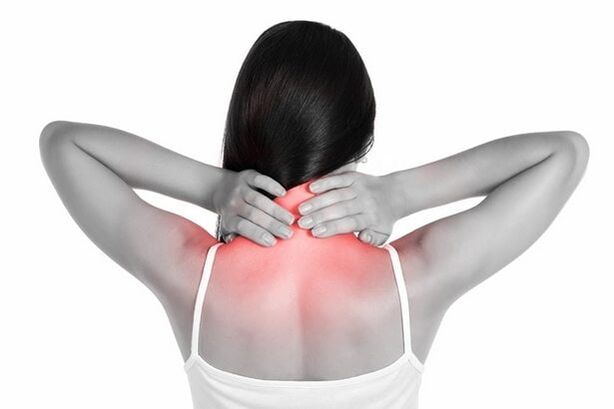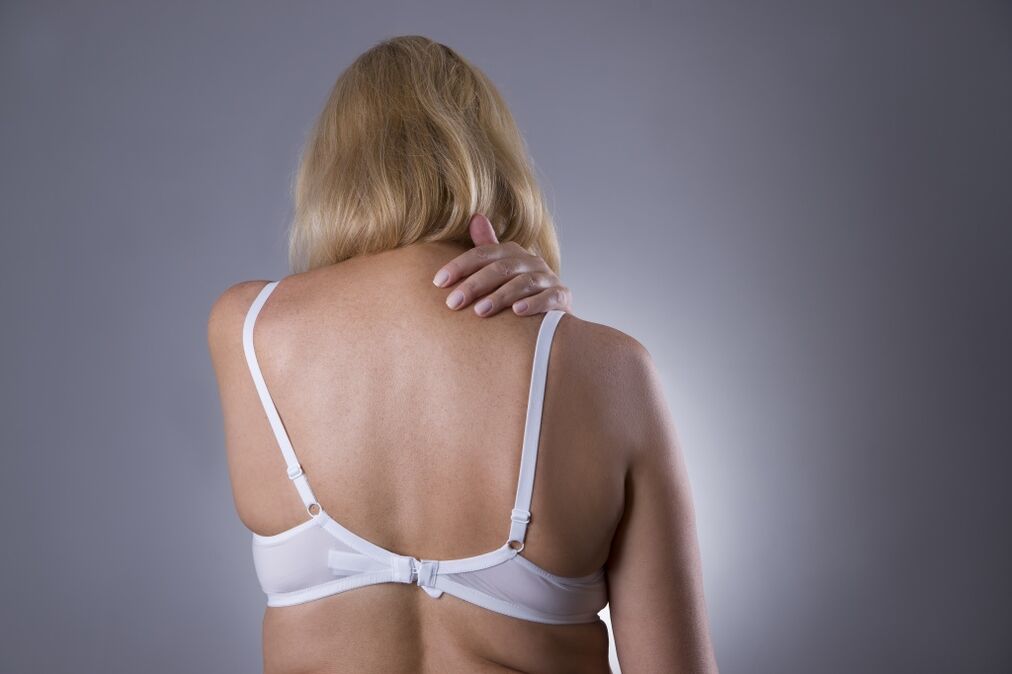

Methods to prevent diseaseOsteochondrosis is a recurrent degenerative-dystrophic pathology which takes place in the context of the progressive destruction of intervertebral discs and bone deformation. It is necessary to exclude from the usual lifestyle the factors causing the deterioration of the trophies of the cartilaginous tissues. It is a low motor activity, an excess weight, excessive physical activity, a deficiency in the diet of products with a large trace of trace elements, vitamins. The progression, osteochondrosis of the cervical vertebrae transmits certain stages which are classified by various symptoms. Distinguish 4 stages from the development of pathology:
Basically, at the first stage of the disease, the unexpressed smoothing of the cervical elbow (Lordose) is noticed. The clinical manifestation is insignificant, not severe neck pain, one can be observed, exacerbating with turns of the head, as well as muscle tension. This step is treated without medication, the main thing is to change nutrition, to do exercises, etc.There is instability between the vertebrae, their displacement, Thuria can occur. The patient has more improved pain transmitted to the shoulders, to the hands. The height of the discs becomes less, because of this, there is a violation of the nerves. The patient feels fatigue, headache, level of work capacity, inattention reductions.There is a decrease in the height of the intervertebral discs, the narrowing of the holes, a hernia begins to form. The pain of the neck and shoulders increases, the muscles of the hands weaken, numbness, discomfort, dizziness occur. The diagnosis determines the low mobility of the neck.At 4 stages, the destruction of the disc is observed, they are replaced by the connective tissue. Such a current hurts several sections of the ridge which are at different stages of the violation. In people, coordination changes, pain, stunning increases, noise in the ears, etc.The signs of the disease in the neck are significantly different from the symptoms of osteochondrosis in another area of the spine. Since the cervical vertebrae are located nearby, the nerve roots and the spinal cord are pinched. This leads to the emergence of these signs:Pain syndrome is located in the neck, neck, shoulders, arms and legs. When joining the nervous receptors, the appearance of uncomfortable sensations in the shoulder area, at the back of the head, hands begin to be rebuilt. Due to spasms in the cervical muscles, blood circulation is disturbed. The occurrence of weakness in the upper limbs is noted, associated with damage to the functionality of the roots, which contribute to the inclusion of the motor nerves which reconstruct muscle tissue in the hands.The upper limbs are rebuilt due to a decrease in sensitivity in them, violations of the roots in which the endings of the sensitive nerve are located.When you turn your head, painful sensations appear, you can also hear a crunch. This is explained by damage in the small joints of the cervical region, a decrease in the level of intervertebral discs.The patient complains of insufficient force, the appearance of fatigue, dizziness, coordination disorders. Due to the displacement of the elements of the spine, the vertebral artery is pressed. For this reason, the blood circulation worsens, which leads to a weakening of the blood supply to the occipital section and the cerebellum.The appearance of vision problems, the loss of sensitivity in the language is noted.Symptoms of cervical osteochondosis in women are no different signs in men. Women who have reached 45 and over, who are diagnosed with such disease, note numbness and tingling in the upper limbs in a dream.Methods for the treatment of cervical osteochondosisThe main signs of osteochondrosis in the cervical region include:pain on the back of the head, neck, arms and shoulder, which intensifies during sneezing, cough and a minimum load on the arm; Burn between the shoulder blades, tingling legs or arms, numbness;Pain and crunch in the neck that occurs during the inclination and the turns of the head;fatigue, weakness;faintings and dizziness resulting from clear turns of the head;The headaches, which generally start at the back of the head, spread to the temples and the crown.The other signs of cervical osteochondosis include noise in the ears, hearing disorders and a decrease in visual acuity. Sometimes the disease is felt by pulling pain in the heart zone. During the first signs of cervical osteochondosis, consult a doctor who will make a complete examination will make a diagnosis. In this case, diagnostic methods such as MRI, laboratory studies, ultrasound, ECG can be used. As well as the Shantsa necklaces - are elastic with plastic or metal inserts, a gesture, inflatable. The devices vary in height, the degree of fixing and in design of the fasteners. It all depends on the negligence, the characteristic symptoms of pinching of the radicular nerve, as well as other factors. How to cure cervical osteochondrosis or reduce its manifestation with drugs:
Non-steroidal anti-inflammatory drugs. Drugs relieve swelling, pain, reduces the patient's condition.Vitamins B with osteochondrosis from the cervical region. Contribute to the acceleration of metabolic processes in soft tissues.Recovery stimulants. They help restore the cartilage fabric even in a damaged disc.A group of drugs that help relieve muscle cramps.Anesthesia.Cervical osteochondosis is treated with conservative methods, and treatment is always complete. The drug treatment is the same for osteochondrosis of any department: using drugs from certain pharmacological groups, but the choice of specific drugs of these groups, dosage, duration of the contribution is individually selected for each patient. The X -ray image of the cervical column after surgical treatment of the C5 - C7 vertebrae is completed by a temporary port of a Chanstz necklace or its varieties. Due to the fixing of the cervical vertebrae, osteochondrosis in the cervical region is treated more quickly. This additional orthopedic device helps to deal with pain, normalize blood flow through neck ships and improve the patient's general condition. The severity of the symptoms of cervical osteochondosis disease depends on the degree of destruction of the structures of the vertebrae. Symptoms are aggravated by the growth of bone tissue with the formation of osteophytes, root syndrome (root pain when it has pinched the nerve), intervertebral hernia (discs of the disc in the vertebral canal). The first signs of the disease are periodic headaches in the neck, pain in the neck, a crunch and clicks in the vertebrae during the turn of the head, sometimes a slight tingling. Over time, the symptoms develop and the intensity of the pain intensifies. It is difficult to raise your hand on the side of the defeat - immediately there is a blow in the shoulder or the neck. The restriction of the movements of the head due to pain often occurs in the morning after sleep in an uncomfortable position. The disease leads to pressing the roots of the peripheral nerves (Roing syndrome) and causes pain along these nerves. It is possible to numb hands or fingers, a violation of the sensitivity of certain skin areas innervated by a pinched nerve.

Methods for the treatment of cervical osteochondosisThe main signs of osteochondrosis in the cervical region include:pain on the back of the head, neck, arms and shoulder, which intensifies during sneezing, cough and a minimum load on the arm; Burn between the shoulder blades, tingling legs or arms, numbness;Pain and crunch in the neck that occurs during the inclination and the turns of the head;fatigue, weakness;faintings and dizziness resulting from clear turns of the head;The headaches, which generally start at the back of the head, spread to the temples and the crown.The other signs of cervical osteochondosis include noise in the ears, hearing disorders and a decrease in visual acuity. Sometimes the disease is felt by pulling pain in the heart zone. During the first signs of cervical osteochondosis, consult a doctor who will make a complete examination will make a diagnosis. In this case, diagnostic methods such as MRI, laboratory studies, ultrasound, ECG can be used. As well as the Shantsa necklaces - are elastic with plastic or metal inserts, a gesture, inflatable. The devices vary in height, the degree of fixing and in design of the fasteners. It all depends on the negligence, the characteristic symptoms of pinching of the radicular nerve, as well as other factors. How to cure cervical osteochondrosis or reduce its manifestation with drugs:
Non-steroidal anti-inflammatory drugs. Drugs relieve swelling, pain, reduces the patient's condition.Vitamins B with osteochondrosis from the cervical region. Contribute to the acceleration of metabolic processes in soft tissues.Recovery stimulants. They help restore the cartilage fabric even in a damaged disc.A group of drugs that help relieve muscle cramps.Anesthesia.Cervical osteochondosis is treated with conservative methods, and treatment is always complete. The drug treatment is the same for osteochondrosis of any department: using drugs from certain pharmacological groups, but the choice of specific drugs of these groups, dosage, duration of the contribution is individually selected for each patient. The X -ray image of the cervical column after surgical treatment of the C5 - C7 vertebrae is completed by a temporary port of a Chanstz necklace or its varieties. Due to the fixing of the cervical vertebrae, osteochondrosis in the cervical region is treated more quickly. This additional orthopedic device helps to deal with pain, normalize blood flow through neck ships and improve the patient's general condition. The severity of the symptoms of cervical osteochondosis disease depends on the degree of destruction of the structures of the vertebrae. Symptoms are aggravated by the growth of bone tissue with the formation of osteophytes, root syndrome (root pain when it has pinched the nerve), intervertebral hernia (discs of the disc in the vertebral canal). The first signs of the disease are periodic headaches in the neck, pain in the neck, a crunch and clicks in the vertebrae during the turn of the head, sometimes a slight tingling. Over time, the symptoms develop and the intensity of the pain intensifies. It is difficult to raise your hand on the side of the defeat - immediately there is a blow in the shoulder or the neck. The restriction of the movements of the head due to pain often occurs in the morning after sleep in an uncomfortable position. The disease leads to pressing the roots of the peripheral nerves (Roing syndrome) and causes pain along these nerves. It is possible to numb hands or fingers, a violation of the sensitivity of certain skin areas innervated by a pinched nerve.



















